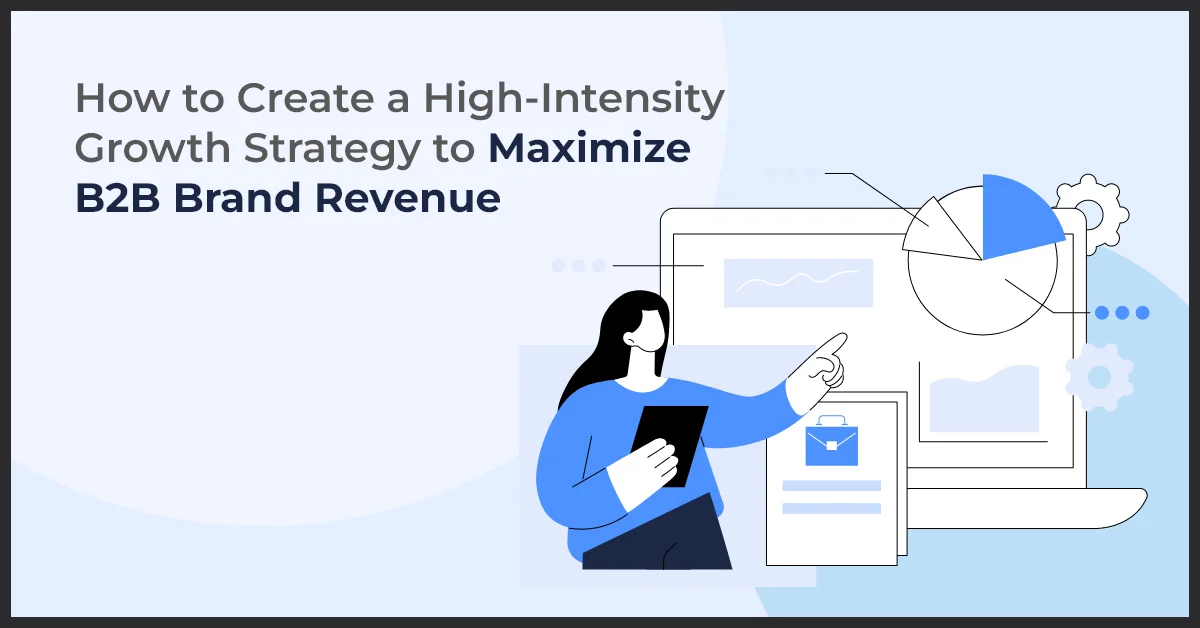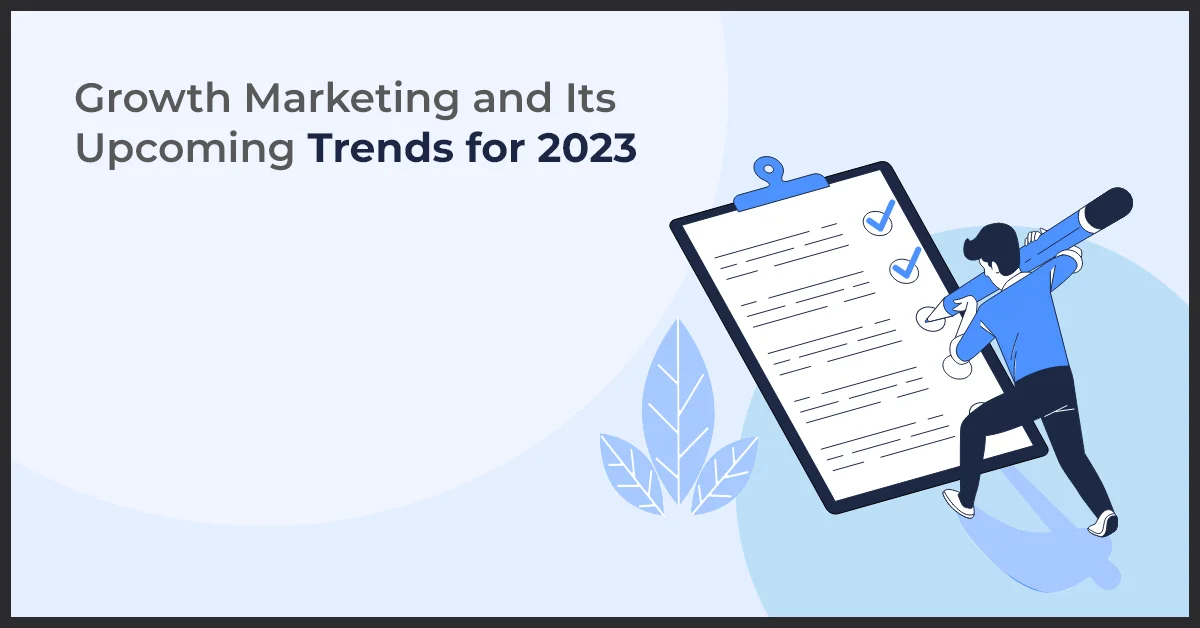How to Create a High-Intensity Growth Strategy to Maximize B2B Brand Revenue

Published on: June 9, 2021
Updated on: April 17, 2024
319 Views
- Marketing Pod
10 min read
When we talk about B2B branding in 2021, the entire focus is now shifting toward attaining simplicity in B2B brand marketing efforts. As a marketer, you have probably witnessed people asking questions about building an effective B2B brand strategy, and the majority of them, you have answered with “Let’s start by keeping things simple”...
Which Brings Us to the Question, What Makes a B2B Brand?
In simple terms, B2B (Business to Business) organizations are the ones that market their products and services to other businesses. There are multiple B2B SaaS marketing companies that use each other’s services to benefit their organization’s business.
A wide range of beliefs combined over time represent the core of a brand. In this guide, we will help you understand the present day B2B marketing landscape and give you an insight into the most effective strategies that you can use to generate more leads, increase sales, and boost your revenue.
How Did Things Work in the Past?
If we look at the traditional B2B branding and sales strategy, it was a predictable and controlled path. It was more about printed assets, salesy pitches, trade shows, cold calling, and face-to-face interactions. However, these tactics are now in the rear view and are not as effective as they once were.
Why Traditional B2B Marketing Strategy Doesn’t Work Anymore?
Consumer’s preferences have changed in several ways and the traditional B2B brand strategies do not align with them. Let’s see how:
- Nearly 50% of B2B buyers today are millennials and they are not very fond of cold calls.
- B2B buyers do their homework online today. On average, a typical B2B buyer conducts at least 12 online searches before getting in touch with a business’ marketing management team. In fact, they are halfway through making their mind about buying a product before getting in touch with a team and most of their purchases are influenced by B2B content marketing activities.
- Compared to the past, more people are involved in B2B purchases today.
- Nearly 90% of B2B prospects go back and forth between the sales funnel to reconsider their choices or complete additional tasks before making a purchase.
It’s All About Delivering an Experience
In order to cater to the needs of modern B2B customers and guide them through the different stages of the funnel, your strategy should take into consideration the following:
Demand Generation
As we say, it all starts from the top and in this case, a buyer’s journey starts at the top of the funnel (TOFU). It is here you create awareness about your brand and get people interested in your products and services.
Use this stage to identify your customer’s needs, explore solutions for their pain points, and gather information about their requirements.
Lead Generation
Once customers are through TOFU, it is time to turn their interest into action during the middle of the funnel (MOFU). It is essential to land every lead in the funnel and optimize the ways you follow for lead generation.
Customer Retention and Brand Advocacy
Once leads are converted at the bottom of the funnel (BOFU), the next step to boost revenue is to stay on the right track and retain your customers. It is difficult to maintain B2B brand loyalty but with the right engagement, you can turn your regular customers into brand advocates.
Learn more about how to optimize your marketing funnel to generate more leads and increase revenue, in our eBook.
How to accomplish the aforementioned objectives?
As marketers, we have probably read about the strategies listed below on a surface level, but rarely do we get a chance to explore what actually needs to be done.
When creating a B2B marketing plan, you can only achieve the desirable results by finding the right mix of channels below. Let’s take a look at them:
- Website
- Social media marketing
- Content marketing
- Video marketing
- PPC - Pay per click advertising
- SEO - Search engine optimization
- Marketing automation
Now that you have an idea of what framework you can operate within to create a result-oriented B2B marketing strategy, let’s go into detail of it:
Website
Your business is going to be a complete dud without a stunning website. It is the most valuable marketing asset you can have and if you do not have a professional website, it is time to get one urgently!
B2B buyers expect a brand’s website to help them in understanding them. This practice is getting more popular as more millennials take over buying roles leaving the baby boomers behind.
So, what are key characteristics of a good website? Here are a few pointers to get you started:
- Loading time: Loading time of over three seconds will drive away nearly 40% of the users.
- Mobile-friendly/ responsive: If your website is not optimized for mobile devices, be prepared to lose potential customers rapidly. 80% of B2B customers use a mobile device at work and 90% of them will not return on the back of a poor mobile experience.
- Security: Trust is everything and an unsecure website doesn’t promote you as a trustworthy place. Make sure your website is secured with a SSL certificate and uses HTTPS instead of HTTP.
- Call to action: A website is a 24 hours sales representative. If your website doesn’t have a clear CTA or engaging contact form, you can lose up to 44% of your potential customers.
- Poor design: 37% of B2B buyers leave if you have a poorly designed website. Be it navigation, design, or engagement options, a bad website equals disaster.
Social Media Marketing
Social media is the modern day billboard and can help your brand substantially. Remember, not all social media platforms are well-suited for every business and it is your job to find out which platform can help you in reaching your target audience.
If you are not sure about which platform to choose, it is a good idea to hire a social media marketing company. Once you are through with it, here are best content types to boost B2B demand generation through social media posts:
- Blog posts
- Interesting facts about business
- Webinars
- Industry specific news updates
- Attention grabbing brand videos (30 to 60 seconds long)
- Case studies
- Infographics
B2B Content Marketing
Content marketing is one of the most important tools that all B2B branding teams use. It consists of assets like social media posts, blogs, press releases, videos, articles, newsletter, case studies, infographics, white papers, and more.
Nearly 50% of B2B buyers go through at least eight pieces of content when exploring a brand. Content published on your website and social media accounts plays a major role in influencing a customer’s purchase decision.
Now, most marketers would say that they do it all, then why don’t they get the desired traction. The answer is, you have probably made the content marketing all about yourself.
A good marketer knows that content should enable prospective customers to pursue buying tasks. In order to achieve this, you can try the following:
- Have a clear idea of the tasks that you want your customers to complete during their purchase journey
- Provide solutions, information, and tools needed to complete the said tasks
- Make the information available to your customers through their preferred communication channels
Video Marketing
A vast majority of B2B customers research and watch product videos during their buying journey. Online videos are one of the fastest ways to transmit relevant information to your prospects in an engaging manner.
In fact, users retain 95% of the information consumed through videos while they only retain 10% when reading the same information.
You can get your user’s attention by using the following type of videos in your strategy:
- Pre-roll or mid-roll YouTube advertisements
- Descriptive how-to videos
- Blog videos
- Quirky and engaging videos
- Videos that tell a story
PPC - Pay Per Click Advertising
The top ads that appear on the top of search results pages are PPC search ads done right. In fact, a lot of people believe that paid search ads make it easier to find information they are looking for.
These can be used well during MOFU. You can bid on keywords and phrases that improve traction and bring more customers to your website. If you can get through the noise and bid for the right keywords, you can reduce ad spend costs and improve your ROI.
SEO - Search Engine Optimization
You cannot build an online presence without focusing on SEO. It can be used in both lead generation and demand generation stages. However, for B2B digital marketing, you will need to focus your SEO efforts around high-commercial-intent keywords and phrases, which include:
- Keywords related to purchase
- Contact-focused keywords like ‘request, call, contact and more’
- Location specific keywords
- B2B branding and competitor keywords
In case you are just looking for a single B2B marketing channel to push your brand on, make sure it is SEO.
Marketing Automation
As the adage goes, “Old is gold.” When we talk about marketing automation, the first thing that comes to our mind is email marketing. Although a traditional B2B marketing strategy, it has held its ground and continues to grow strong even today.
When done right, customized email marketing can generate over 760% increase in the company’s revenue. Some of the best email marketing examples include:
- Blog newsletters
- Weekly/monthly newsletters
- New product/service offering notifications
- eBooks
- Introduction emails
- Webinar upload updates
Wrapping Up
Now that you are armed with all the information you need to land every lead and boost your revenue, you can start executing your B2B marketing plan.
Nailing a B2B marketing plan is tough, but if you put the information in this article to good use, you can optimize both lead generation and revenue for your brand.
There are no limitations to how you can grow your B2B business incorporating the right combination of the strategies mentioned above. You need to focus your efforts in places that will yield maximum ROI. The key is to measure the results regularly and improve them if they are not what you desired.
Yet another sure-shot and simple way to get things right is to get a Growth Pod with a team of talented marketers at your disposal. Now, what’s a Growth Pod? This is a modern-day methodology that gets you all the tools and specialists to cover every aspect of B2B digital marketing while reducing your spend on hiring different resources by 60%.
To know more about Growth Pod, click here.
A revenue growth strategy is a plan designed to increase a company’s income over time through various tactics such as expanding customer base, launching new products, or entering new markets.
A high-intensity growth strategy is a proactive approach that focuses on rapid and aggressive expansion to maximize revenue and market share within a short period of time.
A high-intensity growth strategy is important for B2B brands because it helps them capitalize on market opportunities, outpace competitors, and achieve rapid revenue growth.
B2B brands can maximize revenue through a high-intensity growth strategy by focusing on acquiring high-value customers, increasing average deal size, accelerating sales cycles, and expanding into new markets or product lines.lity.

